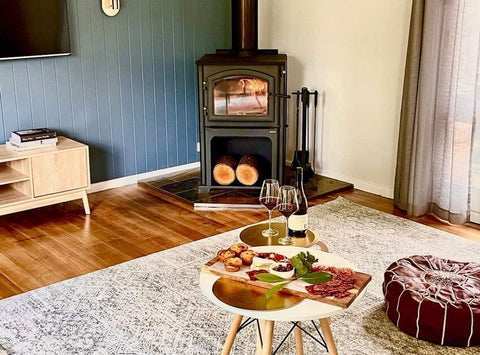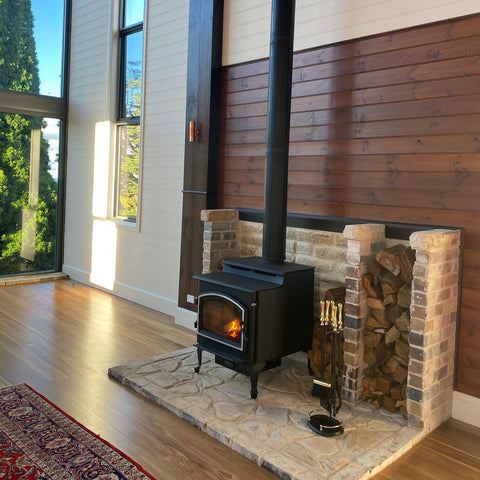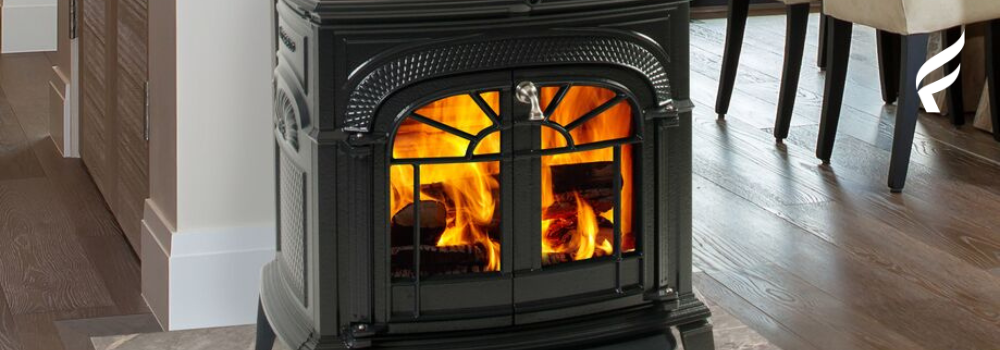As the costs of traditional home heating methods continue to rise, homeowners are increasingly seeking efficient and economical alternatives. The escalating prices of natural gas and heating oil have prompted a shift towards more sustainable and cost-effective solutions.
Beyond their rustic charm and environmentally friendly appeal, wood stoves offer a practical solution to combat the financial strain imposed by conventional heating systems. Harnessing the natural warmth of burning wood, these stoves provide a renewable and affordable energy source.
This blog sets out to explore how wood stoves can not only alleviate these escalating costs but also contribute to a more sustainable and budget-conscious approach to keeping our homes warm and cozy.
Do Wood Stoves and Fireplace Inserts Save Money?
Put simply, yes. Some of the most expensive ways to heat your home—heating oil and gas— experience volatile pricing unlike cost-stable biomass alternatives.
That’s where alternative home heating comes in. Biomass fuels, such as wood, disrupt this cycle of using non-renewable resources by leveraging wood. Wood stoves save more than just money; reductions in carbon emissions, waste and energy dependence all contribute to the growing popularity of wood stoves.
Wood Inserts vs. Traditional Wood Fireplaces
A wood fireplace insert is a heating appliance designed to enhance the efficiency of traditional fireplaces. Retrofit into an existing fireplace space, this unit transforms your hearth into an effective heat source while maintaining the charm of an authentic wood fire.
Wood inserts feature insulated walls and a closed combustion system, preventing heat loss and directing more warmth into the room. Wood fireplace inserts offer a cleaner and more controlled burn, improving both energy efficiency and indoor air quality. With modern technology, fireplace inserts extract the most heat from the wood, extending the burn time and reducing both fuel costs and time reloading fuel.
This upgrade allows homeowners to enjoy the ambiance of a wood-burning fire while maximizing heating performance.
How Much Money Do You Save with a Wood Stove?

To determine how much money you can save by switching to wood fuel, let’s first examine the differences in fuel price.
In terms of a wood fuel winter stockpile, a general guideline suggests storing two to three cords for every 1,000 square feet of heating space. So, for a 2,000 square-foot home, four to six cords would suffice for a winter. The cost of wood varies based on factors like self-sourcing or using a supplier. On average, in Northeastern states, four cords of wood might cost $1,000, or $1,500 for six.
Alternatively, a typical homeowner in the Northeastern United States consumes five to eight gallons of heating oil daily, resulting in an expense ranging from $21.80 to $34.88. When extended over the heating season from November to March, encompassing 151 days, these costs accumulate rapidly, reaching an annual total between $3,291.80 and $5,266.88.
In this example, by switching to wood, you could save over $1,791.80 on heating costs annually.
How Long Does It Take for a Wood Stove to Pay for Itself?
The time it takes to pay off your investment depends largely on the stove, installation and venting costs.
To calculate the breakeven point, determine your annual savings by subtracting the difference in costs between your new heating method and the previous one. Then, divide this annual savings by the total investment for installing the new stove to get an estimate of the number of years required to recoup your initial investment. This approach helps assess the financial viability and timeline to recover the costs associated with transitioning to a new heating system.
How to Increase Heating Efficiency for Cost Savings
Ensure Proper Insulation

To optimize cost savings with a wood stove, conducting a home energy audit is crucial. Identifying and addressing the primary sources of heat loss, such as windows and doors, can significantly enhance energy efficiency. Investing in measures like caulking, sealing doors and windows and opting for double-pane windows helps combat these losses, ensuring that the warmth generated by the wood stove remains within the home.
This proactive approach not only boosts the effectiveness of the heating system but also contributes to substantial long-term savings on energy bills.
Implement Zone Heating
Zone heating, a savvy strategy for wood stove users, can lead to cost reductions of up to 40% on energy bills. This approach involves selectively heating only the areas actively used, allowing homeowners to avoid unnecessary energy expenditure. By sealing off spaces like attics, extra rooms, and storage areas that don't require heating, one can maximize the wood stove's impact, directing warmth precisely where it's needed. Embracing zone heating not only enhances comfort but also ensures a more economical and sustainable use of energy resources.
Practice Routine Maintenance and Cleaning
Maintaining the proper function and efficiency of your wood stove is paramount for maximizing cost savings. Regular weekly, monthly and periodic maintenance and care routines are essential. Cleaning out ash, inspecting components and ensuring a well-ventilated chimney are key tasks that not only extend the lifespan of the wood stove but also enhance its performance. By dedicating time to routine maintenance, homeowners can guarantee that their wood stove operates at its peak efficiency, translating to optimal heat production and ultimately contributing to long-term financial savings on energy expenses.
Invest in a New Stove

Investing in a new, EPA-certified wood stove is a pivotal step towards cleaner and more efficient burns. These stoves adhere to rigorous environmental standards, ensuring minimal emissions and maximum heat production. The advanced combustion technology not only reduces environmental impact but also boosts fuel efficiency, translating into cost savings for homeowners.
The Most Efficient Wood Stoves by Forge & Flame
Integrating modern technological advancements seamlessly, our wood stoves and fireplace inserts represent our commitment to efficiency, which results in significant cost savings for users. This harmonious fusion of precision engineering and contemporary technology defines our dedication to delivering an outstanding and cost-effective experience for those who choose our wood heating solutions.
Key Technologies
Quad-Burn
Quadra-Fire's patented four-point burn system incorporates four combustion cycles to prolong heat, intensify the fire, and elevate overall efficiency, ensuring robust and enduring performance.
Automatic Combustion Control
Quadra-Fire's Automatic Combustion Control (ACC) ensures precise start-up and air control, resulting in uniform and sustained burns. ACC intelligently supplies the fire with air precisely when it's most crucial, maintaining control for consistent and extended burning periods.
Vermont Castings
Vermont Castings’ engineering excellence enhances your heating efficiency while reducing stove emissions, ensuring optimal performance and getting the most out of every load of wood in three stages. In the first stage, the bypass damper opens, fueling the primary burn with fresh air. Then, the damper is closed once stove and flue are sufficiently hot, forcing smoke into the secondary combustion chamber. In the third and final stage, the catalyst increases efficiency and lower emissions result from tertiary burning of gases and CO.
FlexBurn Technology
On two of our products we offer the catalyst as an option, these FlexBurn units allow are just as efficient but also offer that series wood burner the option to add the catalyst or “performance pack” to kick their efficiency into high gear.
C3 Technology
Vermont Castings’ exclusive Continuous Combustion Control (C3) technology takes care of everything seamlessly. Calibrated to ensure optimal burns throughout your fire's lifespan, this heat-activated system operates without the need for electricity or manual adjustments. From ignition to the last glow, C3 technology adeptly manages air intake, automatically fine-tuning and providing the perfect amount for maximum efficiency and heat output. The result? The most consistently easy burn you'll ever experience.
Thermostatically Controlled Combustion
Vermont Castings’ Thermostatically Controlled Combustion is a distinctive built-in thermostat operating without the need for electricity, automatically regulating the necessary air for combustion. Simply adjust the stove to your desired heat output, and let the thermostat handle the rest. The outcome is prolonged, evenly distributed heat.

Save Money With a Wood Stove
Beyond their rustic charm and eco-friendly appeal, wood stoves offer a practical remedy for the financial strain imposed by conventional heating systems. By harnessing the natural warmth of burning wood, these stoves present a renewable and affordable energy source.
For support in finding the right wood stove or insert for you, explore our robust selection online, or visit a local Forge & Flame dealer near you.


